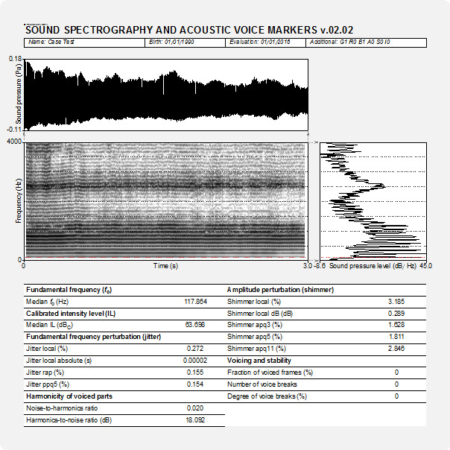Description
Vocal fundamental frequency (v.02.04)
Vocal fundamental frequency (vocal fo) is one the key factors in clinical voice sound assessment. With the PHONANIUM script for measuring and showing vocal fundamental frequency in the program Praat, all relevant aspects and statistics regarding vocal fo can easily be obtained for different voice/speech tasks.
Authors of the Vocal fundamental frequency v.02.04 script
Youri Maryn
Included in this download
- Access to tutorial video with concise theory and illustration(s) on how to work with this Vocal fundamental frequency script
- Access to tutorial video with concise theory and illustration(s) on how to evaluate the quality of sound recordings
- Access to tutorial video on how to work with the Personal information – New file script
- Access to tutorial video on how to implement/install plug-ins in the program Praat
- This plug-in
Plug-in details
Name of plug-in
plugin_PHONANIUM_VocalFundamentalFrequency_v.02.04
Content of plug-in
- Vocal fundamental frequency v.02.04.praat: to determine several numerical data and graphs related to vocal fo with PHONANIUM’s script in the program Praat.
- setup.praat: to couple this script to a button in the dynamic menu of the program Praat.
How to install this plug-in?
First, make sure to have downloaded and installed the program Praat (free available at www.praat.org) on your computer. Than download this plug-in.
Once downloaded, unzip the folder entitled plugin_PHONANIUM_VocalFundamentalFrequency_v.02.04 and place it in the following directory (i.e., the preferences directory of the program Praat), depending on your computer operating system and the name of the user (for example ‘Emiel’):
- Windows (Vista or later): C:\Users\Emiel\Praat\.
- Mac OSX: /Users/Emiel/Library/Preferences/Praat Prefs/. (However, sometimes the Library folder is hidden on a Mac OSX. If this is the case, you first open Finder, select the Go menu, and then press the alt key ⌥. While pressing the alt key ⌥, the Library becomes available as an option in the Go menu and can then be clicked/opened.)
- Linux: /UserName/.praat-dir/.
What is vocal fundamental frequency?
Vocal fundamental frequency refers to the repetition rate of a recurring waveshape in the voice signal, i.e., the number of cycles per unit time in the vibration of the vocal folds. It is mutually reciprocal to period (T0): fo =1/T0 and T0=1/ fo. This is synonymous to the vocal vibratory rate, which is expressed in hertz (Hz). One vocal period or cycle typically consists of an opening phase, an open phase, a closing phase and a closed phase of the vocal folds. A vibration with 1 cycle per second has a frequency of 1 Hz. A vibration with 100 cycles per second has a frequency of 100 Hz. This is a typical vocal fundamental frequency for adult males. A vibration with 200 cycles per second has a frequency of 200 Hz. This is a typical vocal fo for adult females.
Although not completely equal to, it is highly correlated with perceived pitch. This means that higher sounding voices stem from vocal fold vibrations with more cycles per second, and vice versa.
What determines vocal fundamental frequency?
Vocal fo or pitch is determined by multiple interconnected factors. First, it increases with vocal fold length in modal register and speaking voice, but in falsetto register and singing voice it can sometimes decrease with vocal fold length (Nishizawa et al., 1988; Colton et al., 2006). Second, vocal fundamental frequency inversely varies with mass/thickness of the vibrating part of the vocal folds. This implies that vocal fo is relatively low in thicker vocal folds, because they are supposed to vibrate slower. Thinner vocal folds vibrate faster and therefore produce higher sounding voices (Colton et al., 2006). Third, tension in the vibratory part of the vocal folds is important as well, especially in falsetto register, as vocal fo raises with it (Colton et al., 2006). Because vocal folds are elastic/deformable structures with different densities and movements depending on internal depth/place, and because they consists of multiple layers each with their own vibratory characteristics, Titze (2011) proposed a model in which the following items are relevant to vocal fundamental frequency: membranous vocal fold length, passive tissue strain, maximal actice tissue strain, tissue density, medial-lateral depth of the vibration, medial-lateral depth of the vibration of the thyroarythenoid muscle, and activation level in the thyroarythenoid muscle. Although more complex, this model takes the exceptional vibratory properties of the vocal folds into account to explain vocal fo.
What influences vocal fundamental frequency?
Most importantly, vocal fo strongly depends on the structure of the vocal folds and the elasticity of their tissues. Changes in or disruption/pathology of vocal fold structure and tissues may therefore cause alterations in vocal fundamental frequency. Vocal fo is known to increase/decrease in cases with muscle tension dysphonia, vocal nodules, cyst, granuloma, contact ulcus, edema/polipoid mucosa, laryngitis, puberphonia/mutational falsetto, lesion of the recurrent laryngeal nerve, lesion of the superior laryngeal nerve, etc. (Mathieson, 2001). Furthermore, as age and gender greatly affect vocal fold structure and elasticity, they also have an important influence on vocal fo. In general, vocal fundamental frequency (a) is in our first years the same between girls and boys, (b) starts to diverge between girls and boys as they become teenagers, (c) decreases clearly during puberty, especially in boys, (d) differs strongly between adult (post-pubertal) females and males, (e) decreases slightly during adulthood, and (f) increases slightly at older age, especially in males (Baken & Orlikoff, 2000). Such a course of vocal fo has everything to do with anatomical, histological and physiological changes that occur in the larynx from birth to old age. Important factors are growth, hormones (especially sex hormones), health, professional and recreational voice use, life style (especially smoking and alcohol), environment (especially noise and air condition), psychological status, culture and degenerative processes with aging (Mathieson, 2001). Finally, speech task may also influence vocal fo. In children, mean vocal fundamental frequency in spontaneous speech is slightly higher than during reading a text. This is the opposite in adults (Baken & Orlikoff, 2000).
Vocal fundamental frequency as treatment outcomes measure
As abnormal vocal fo can be pathognomonic in several laryngeal pathologies (e.g., too high in mutational falsetto dysphonia, or too limited in the higher notes in injured superior laryngeal nerve) and may in the course of time or treatment, it is crucial to objectively measure vocal fundamental frequency in clinical assessment and follow-up of larynx and vocal folds. As such, vocal fundamental frequency is one the key elements in documenting an individual’s voice and in tracking outcomes of voice treatment. With this PHONANIUM script for the program Praat, several descriptive statistics (i.e., minimum, maximum, 10th/25th/75th/90th percentile, median, mean, standard deviation, interquartile range, and range between 10th and 90th percentiles) of vocal fo in both hertz and semitone become readily and rapidly available, as well as a graph showing its progression in time and and a graph displaying its absolute distribution. All this information can be collected on whatever speech task the clinician intends to analyze: steadily sustained vowel, spontaneous speech, read text, gliding tones, singing, diadochokinetic syllable repetitions, etc.

Phonanium’s script for vocal fundamental frequency: specific features
Pre-analysis functions and formatting

Before analyzing the voice/speech signal, the user is prompted in a form:
- to decide on the fundamental frequency window in which vocal fo statistics are to be found;
- to enter personal information (i.e., name, date of birth, date of assessment and additional information) directly in this form, or to take this information after having it entered in the form of the Phonanium script entitled ‘Personal information’.
Graphical information output
- Oscillogram (sound wave)
- fo in time
- Histogram of distribution of fo
Numerical/statistical information output in Hz as well as semitone (relative to 1 Hz)
- Minimum
- Maximum
- 10th percentile
- 25th percentile (or 1st quartile)
- Median ( or 50th percentile, or 2nd quartile)
- 75th percentile (or 3rd quartile)
- 90th percentile
- Mean
- Standard deviation
- Interquartile range
- Range between 10th and 90th percentiles
Important: quality of sound recording
Many of the acoustic analyses and clinically relevant voice markers in the scripts of PHONANIUM imply sophisticated and complex procedures. However, when they are run on signals with bad recording quality, they loose their clinical value in terms of validity and reliability. So, prior to undertaking high-standard acoustic voice analyses, clinicians have to make well-considered choices in all of the following elements in the audio recording chain: room acoustics and ambient noise, type and placement of microphone, microphone preamplifier, and digital audio capturing device. To sample all relevant vocalizations and speech tokens as least polluted by recording-related noise as possible is what it essentially comes down to. For example Maryn (2017) offers an overview on how to deal with this. However, it is fair to note here that estimates of vocal fundamental frequency are not as easily influenced by sound recording quality as other vocally relevant sound measures (for an overview: Maryn et al., 2017).
Click here to visit PHONANIUM’s page on how to minimize recording-related influences on voice/speech signals.
Important: use the ‘Personal information’ script
With the script ‘Personal information v.01.02’ the user can complete an electronic form with the subject’s/patient’s name, date of birth, date of assessment, and optionally extra information. All this information (a) is than written into a table, (b) will be consulted by the other PHONANIUM scripts if the option “Take from ‘Table personalInformation’” is selected, and (c) will be written automatically in the output of these scripts. This increases the user-friendliness of working with PHONANIUM scripts in the program Praat, as the user/clinician has to complete this personal information only once during the entire voice assessment session.
Click here to visit PHONANIUM’s page on this ‘Personal information v.01.02’ script.
Disclaimer
For customers in the EU: this software currently has no CE certification. We are in the process of application. In the meantime, this software can be used for scientific as well as educational/learning purposes.
Program Praat
Click here to visit the website where the program Praat (Paul Boersma & David Weenink, Institute for Phonetic Sciences, University of Amsterdam, The Netherlands) can be downloaded. This software runs under the GNU General Public License. Click here to download this license.
References
Baken RJ, Orlikoff RF (2000). Clinical measurement of speech and voice. San Diego, CA: Singular Publishing Group.
Colton RH, Casper JK, Leonard R (2006). Understanding voice problems. A physiological perspective for diagnosis and treatment (3rd edition). Philadelphia, PA: Lippincott Williams & Wilkins.
Maryn Y (2017). Practical acoustics in clinical voice assessment: a Praat primer. Perspectives of the ASHA Special Interest Groups, SIG3, 2, Part 1.
Maryn Y, Ysenbaert F, Zarowski A, Vanspauwen R (2017). Mobile communication devices, ambient noise, and acoustic voice measures. Journal of Voice. 31, 248.e11-248.e23.
Mathieson L (2017). The voice and its disorders. London, UK: Whurr Publishers.
Nishizawa N, Sawashima M, Yonemoto K (1988). Vocal fold length in vocal pitch change. In Fujimura O (editor): Vocal fold physiology, volume 2. Vocal physiology: voice production, mechanisms and functions, 75-82. New York, NJ: Raven Press.
Titze IR (2011). Vocal fold mass is not a useful quantity for describing F0 in vocalization. Journal of Speech, Language, and Hearing Research, 54, 520-522.
Additional reading on vocal fo, perceived pitch and related issues
Behrman A (2007). Speech and voice science. San Diego, CA: Plural Publishing.
Hirano M (1981). Clinical examination of voice. Vienna, Austria: Springer-Verlag.
Kent RD, Read C (2002). Acoustic analysis of speech (2nd edition). San Diego, CA: Singular Publishing Group.
Kreiman J, Sidtis D (2011). Foundations of voice studies. An interdisciplinary approach to voice production and perception. Chichester, UK: Wiley-Blackwell.
Ma EP-M, Yiu EM-L (2011). Handbook of voice assessments. San Diego, CA: Plural Publishing.
Titze IR (1994). Principles of voice production. Englewood Cliffs, NJ: Prentice Hall.
Titze IR (2006). The myoelastic aerodynamic theory of phonation. Iowa City, IA: National Center for Voice and Speech.
Updates
Vocal fundamental frequency (v.02.04), 27/01/2019
- Addition of a free field for the gender entry under ‘personal information’, to account for issues related to gender diversity.










Reviews
There are no reviews yet.